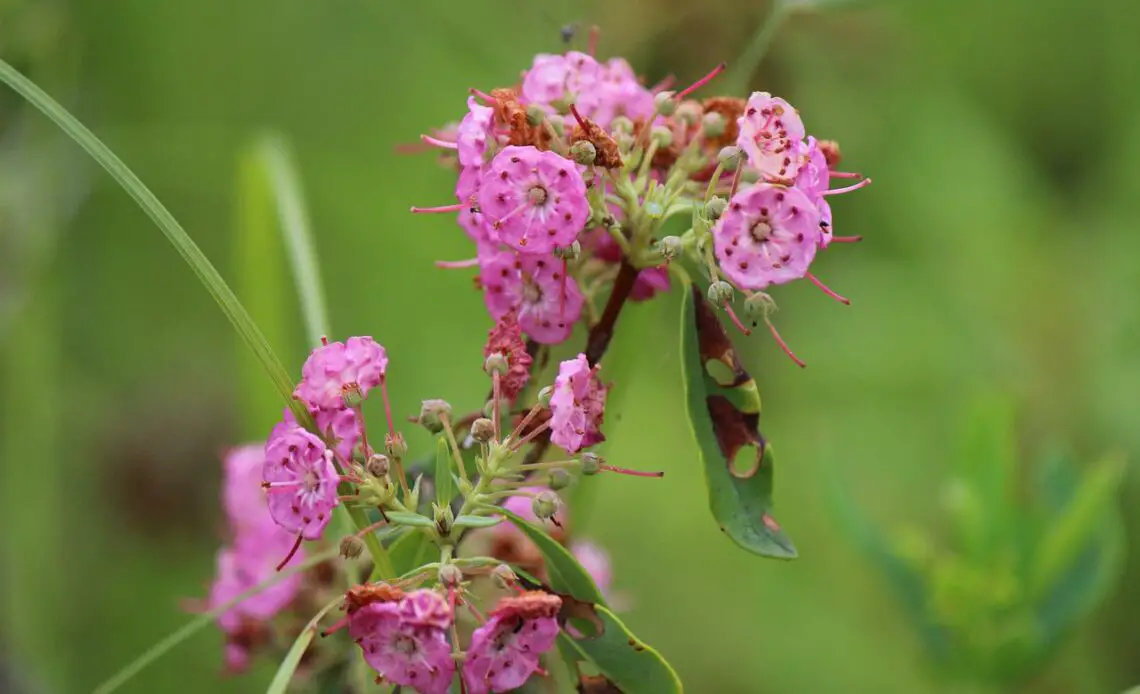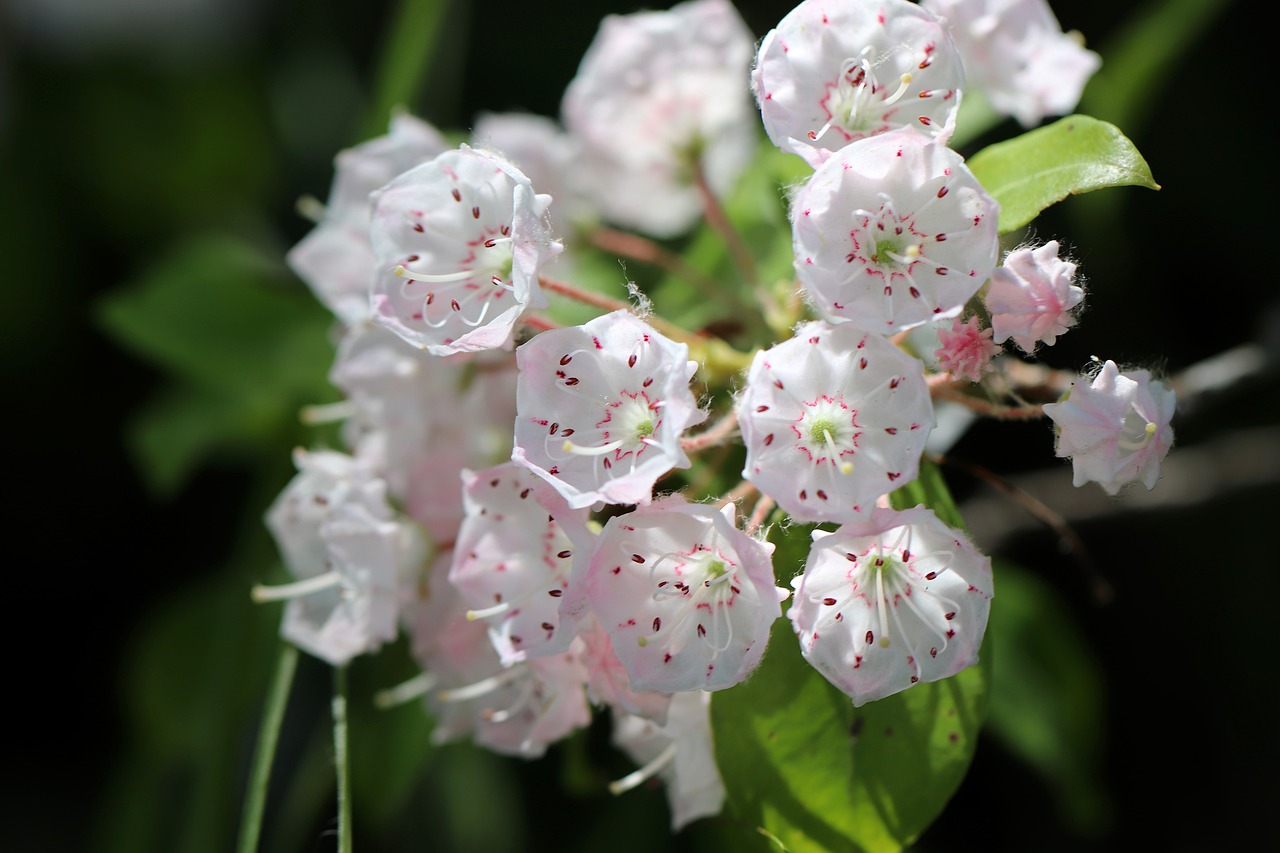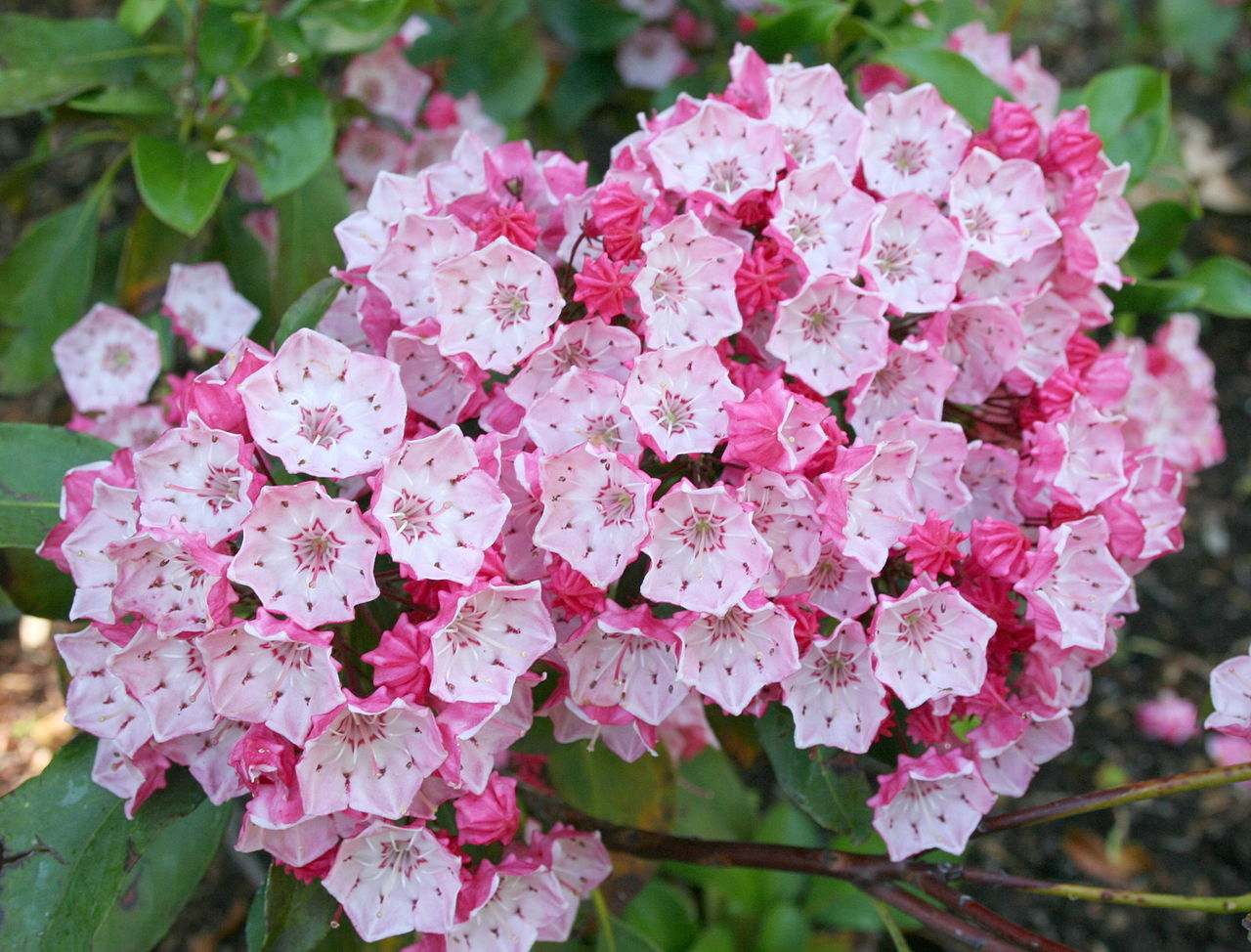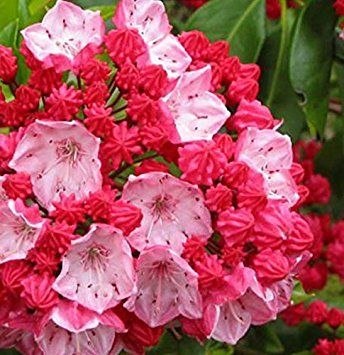
Last updated on May 21st, 2023 at 09:53 am
Kalmia flower belongs to the Ericaceae family, which includes cranberry, blueberry, yew, and heath. Even though this flower is ornamental, it is both highly toxic and edible.
Kalmia flowers are the most impressive flowers of the coastal gardens. It is also known as mountain laurel, in bright white or pink cup-shaped blossoms growing in clusters. They bloom in swamps, meadows, and woods.
This flower is found across the world and in Germany and Poland, as per fossil records, but they are not limited to Cuba and North America. Most of the varieties are limited to Canada and the Eastern coast of the United States.
Until the 1800s, it didn’t spread to Europe and the rest of the world as an ornamental plant. It can grow 6 to 10 feet tall as a rounded shrub, dense, opening up, and developing knotty branches with age.
The Kalmia flower is not a single plant, it is a genus. There are around 7 plants within the genus. Due to reorganization, some are subtracted or added each year. Kalmia procumbens is a variety grown at the highest elevations in its native habitat.
Kalmia flowers are also known as Kalmia latifolia. Its scientific name originated from “Pehr Kalm,” a Swedish Botanist who explored plant life in eastern parts of North America. It is more similar to bay laurels, natives of the Mediterranean.
Kalmia flowers are known as spoonwood as their wood is toxic. It is also called calico bush due to its patterned and speckled flowers.
This flower is also known as the mountain laurel, but it is not a true laurel. It is similar to the true bay laurel due to its long and narrow leaves.
What does the Kalmia (Mountain Laurel) flower symbolize?
The Kalmia (mountain laurel) flower symbolizes perseverance due to its growth in tough habitats. It has crooked trunks and a habit of growing closer together. It grows in inaccessible, rocky, steep, and high-elevation areas.
It is a boundless way to show a person that you are gratified of them for succeeding despite tough situations. They are also termed as a sign of betrayal. These flowers have powerful symbolic value and a rich history.
Apollo, the god of archery, music, dance, and several other aspects, fell in love with Daphne in Greek mythology. She didn’t want to spend time with the infatuated god, so she was transformed into a laurel tree as she tried to flee.
As a token of his devotion, he plucked a branch from the tree. Instead of representing ambition or endurance, the mountain laurel in this narrative represents Daphne’s betrayal by rejecting to love Apollo.
The Kalmia flowers are bright and stunning blossoms; these flowers have been raised as aesthetic and gardening flowers. It has been used to beautify many portions of the artwork, and its gorgeous oval, cup-shaped blossoms set them apart and render them unique. It’s a lovely flower with amazing colors that complement its artistic attributes.
Kalmia flowers are commonly used in rituals and occasions commemorating major afflictions people have faced throughout their lives. People give this flower to someone who has accomplished something truly extraordinary in their area of employment or education.
The most remarkable quality of Kalmia flowers is their capacity to thrive in environments that are unsuitable for most flora, such as mountain range locations. Regardless of the hurdles, this flower can grow in harsh settings and bloom magnificently.
It is noted for its capacity to adjust well to unfavorable environments and for its capacity to persist irrespective of where it is discovered. This flower tells you to remain strong and have faith in your capacity to fight as much as possible.
The Kalmia flower’s meaning is associated with history. Significance with a great influence on what it symbolizes and speaks for. It symbolizes treachery or deceit by someone you feel about. If someone has bothered you and you want folks to realize this is the flower to send them.
All in all, the Kalmia (mountain laurel) flower symbolic meanings are:
- beauty
- ambition
- perseverance
- treachery
- purity
- innocence
- spirituality
Meaning of the Kalmia (Mountain Laurel) flower colors
White color

White represents purity, revival, loss, memories, recovery, and healing. The bloom of the white Kalmia (mountain laurel) is appropriate to give to someone genuine. You can also give them to someone who is physically unwell to convey your best wishes for a speedy recovery.
Pink color

Pink is a color that represents affection, warmth, kindness, friendship, youth, and the early stages of love. Giving pink Kalmia (mountain laurel) flowers as a gift to anyone you care about sends them a message of affection and love.
Red color

Red is a color that represents passionate love, sensuality, fortune, healthy life, and full of hope. The red Kalmia (mountain laurel) flower conveys romance, wealth, love, and good health. This flower might be a wonderful gift to commemorate your love and passion with your sweetheart on anniversaries and Valentine’s Day.
Burgundy color

The burgundy Kalmia (mountain laurel) flower signifies elegance, devotion, romance, luxury, and wisdom.
Purple color
Purple is associated with prosperity, sophistication, loyal devotion, and intelligence. Purple Kalmia (mountain laurel) flower might be an excellent floral gift for people you trust or regard as a leader, conveying a message of respect and honor.
Interesting facts about the Kalmia (Mountain Laurel) flowers
- The Kalmia (mountain laurel) flower is the state flower of Pennsylvania and Connecticut.
- Kalmia flower does not have a particular fragrance.
- All parts of the Kalmia plant are toxic, including the nectar from flowers and wood. The honey made from these flowers should not be consumed. The wood can be used for decorative purposes by carving it. It is a good pollinator as it attracts birds and bees.
- These flowers can be dangerous for livestock. It is also known as “Lambkill” or “Sheep’s Laurel.” Settlers found that even a small number of twigs or leaves would kill their sheep and young lambs due to their low body weight.
- Kalmia is dangerous to humans too. It causes stomach upset, vomiting, and skin and eye irritation. If the bees heavily feed on Kalmia flowers, they produce honey that can be toxic for human consumption.
How to grow Kalmia (Mountain Laurel) flowers
The Kalmia (mountain laurel) is fairly easy to grow in most climates. They are great, beautiful blooming shrubs, perfect for mass plantings in a shady spot in your garden or foundation plantings.
- Plant the Kalmias (mountain laurel) in cool, moist but well-drained, acidic soil.
- Place the shrub in a spot with partial shade.
- Water every three to four days for the first few weeks.
- Give enough water to thoroughly moisten the soil without making it soggy.
- Water it about once a week for the rest of the first growing season.
How to care for Kalmia (Mountain Laurel) flowers
- Once established, water the soil of Kalmias (mountain laurel) every two to three weeks in the spring and every week in the summer.
- Feed the shrub with an acid fertilizer in spring to encourage more vigorous blooming.
- Remove dead or broken branches anytime.
- Do shaping pruning in the spring, just after blooming is completed.
- Deadhead spent flower clusters after the blooms fade.
Best time to gift Kalmia (Mountain Laurel) flowers
Kalmias (mountain laurel) are popular garden plants and well-known ornamentals. Depending on the meaning of the colors of Kalmia flowers, it can be to communicate or send a message.
It can help to communicate that you felt someone acted unfairly or evasively due to this flower’s deceitful meaning. Due to the dishonest meaning ascribed to this blossom, it can assist you in indicating that you feel somebody performed dismissively or perhaps unjustly.
It can also be used as a flower gift to celebrate someone who has overcome adversity for a positive message. The blossoms of the laurel flowers are sometimes used as a sign of endurance by current flower admirers. This relates to the plant’s preference for rocky, difficult, steep, and high-altitude environments. It’s a terrific approach to express your admiration for someone who has succeeded despite adversity.
They can be a part of the floral arrangement or landscape to appreciate its dual meaning of deceit and resilience.
Conclusion
Kalmia (mountain laurel) flowers are usually patterned or speckled, giving them various meanings depending on the color combinations.
Because the flower was only discovered in the New World, it had no significance in ancient Greek culture or throughout the Victorian era. Modern definitions include endurance, trickery, and cleverness.
If you want to know and learn more about flowers, we at PansyMaiden can help you. Check out our fun, easy-to-read, and informative flower-related content that you will surely enjoy!
